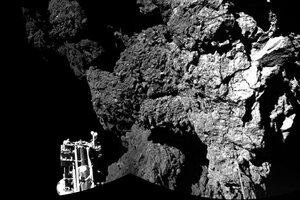Scientists 'confident' comet lander will wake up
The Philae lander is expected to wake up once it nears the sun, scientists involved in the project believe.

The combination photo of different images taken with Philae's CIVA camera system released by the European Space Agency on Nov. 13, 2014 shows Rosetta’s lander Philae as it is safely on the surface of Comet 67P/Churyumov-Gerasimenko.
ESA/AP
Berlin
There is a strong chance Europe's comet lander will wake up from hibernation as it nears the sun, raising hopes for a second series of scientific measurements from the surface next year, scientists involved in the mission said Monday.
The Philae lander, which became the first spacecraft to touch down on a comet Wednesday, has already sent reams of data back to Earth that scientists are eagerly examining. But there were fears its mission would be cut short because it came to rest in the shadow of a cliff.
Shortly before its primary battery ran out, the European Space Agency decided to attempt to tilt the lander's biggest solar panel toward the sun — a last-ditch maneuver that scientists believe may have paid off.
"We are very confident at some stage it will wake up again and we can achieve contact," Stephan Ulamec, the lander manager, told The Associated Press.
That should happen next spring, when Philae and the comet it is riding on — called 67P/Churyumov-Gerasimenko — get closer to the sun, warming up a secondary battery on board. A few days of sunshine on the solar panels should be enough to charge the battery sufficiently to conduct science runs, said Ulamec.
Before they can say for certain if they'll be able to restore contact with Philae, scientists first need to find out where on the 4-kilometer (2.5-mile)-wide comet the washing machine-sized lander is, he added.
New pictures released Monday offer very good clues about where it has come to rest.
The high-resolution images taken from Philae's mother ship Rosetta show the lander descending to the comet and again after its first and second bounce. These were caused by the lander's failure to deploy its downward thrusters and harpoons.
Scientists at the German Aerospace Center, DLR, said Monday that an initial review of data the lander sent back 311 million miles (500 million kilometers) to Earth showed the comet's surface is much tougher than previously assumed. There's also evidence of large amounts of ice beneath the lander.
Scientists are still waiting to find out whether Philae managed to drill into the comet and extract a sample for analysis.
Material beneath the surface of the comet has remained almost unchanged for 4.5 billion years, so the samples would be a cosmic time capsule that scientists are eager to study.
One of the things they are most excited about is the possibility that the mission might help confirm that comets brought the building blocks of life — including water — to Earth.

